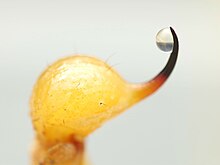| Scorpion sting | |
|---|---|
| Other names | scorpion |
 | |
| Scorpion stinger with a droplet of venom | |
| Specialty | Dermatology, Emergency medicine |
| Symptoms | Pain, bleeding, swelling, parathesia |
| Complications | Envenomation |
| Causes | Scorpions |
| Deaths | deaths from a scorpion are unlikely |
A scorpion sting is an injury caused by the stinger of a scorpion resulting in the medical condition known as scorpionism, which may vary in severity. The anatomical part of the scorpion that delivers the sting is called a "telson". In typical cases, scorpion stings usually result in pain, paresthesia, and variable swelling. In serious cases, scorpion stings may involve the envenomation of humans by toxic scorpions, which may result in extreme pain, serious illness, or even death depending on the toxicity of the venom.[1][2][3]
Most scorpion stings range in severity from minor swelling to medically significant lesions, with only a few able to cause severe allergic, neurotic or necrotic reactions. However, scorpion stings account for approximately 3,000 deaths a year worldwide.[4] The Brazilian yellow scorpion (Tityus serrulatus) is one species known for being especially dangerous, being responsible for most scorpion sting fatalities in South America.[4]
Scorpion stings are seen all over the world but are predominantly seen in the tropical and subtropical areas. In the Western hemisphere, these areas include Mexico, northern South America and southeast Brazil. In the Eastern hemisphere, these regions include Sub-Saharan Africa, the Middle East, and the Indian subcontinent.
- ^ James, William D.; Berger, Timothy G.; et al. (2006). Andrews' Diseases of the Skin: clinical Dermatology. Saunders Elsevier. p. 455. ISBN 0-7216-2921-0.
- ^ Rapini, Ronald P.; Bolognia, Jean L.; Jorizzo, Joseph L. (2007). Dermatology: 2-Volume Set. St. Louis: Mosby. pp. Chapter 83. ISBN 978-1-4160-2999-1.
- ^ Lourenço, W. R.; Cuellar, O. (1995). "Scorpions, Scorpionism, Life History Strategies and Parthenogenesis". Journal of Venomous Animals and Toxins. 1 (2): 51–62. doi:10.1590/S0104-79301995000200002. ISSN 0104-7930.
- ^ a b Chippaux, Jean-Philippe (July 5, 2012). "Emerging options for the management of scorpion stings". Drug Design, Development and Therapy. 6: 165–73. doi:10.2147/DDDT.S24754. ISSN 1177-8881. PMC 3401053. PMID 22826633.